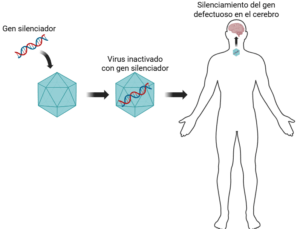Authors: Hasier Eraña
A recent scientific study, developed by Sangamo Therapeutics, explores an innovative gene therapy that has been shown to significantly delay the progression of prion disease in mice and to reach the entire brain in primates.
What does this new therapy involve?
Prion diseases, such as Creutzfeldt-Jakob disease, are caused by the misfolding of a protein naturally present in our bodies: the prion protein (PrP). The new strategy does not seek to directly attack the misfolded proteins (prions), but rather to reduce the production of the normal prion protein. The logic is simple: if there is less normal protein available, the progression of the disease is slowed by the lack of "raw material" to continue generating prions. In this sense, this therapy is similar in its mechanism of action to others whose efficacy is currently being evaluated in humans, such as the therapy developed by Ionis, which also aims to reduce the amount of PrP in the brain.
To achieve this, researchers have designed molecules called Zinc Finger Repressors (ZFRs). These molecules act like a switch that "turns off" or reduces the activity of the PRNP gene, which contains the instructions for making the prion protein.
This therapy, unlike the one Ionis is developing, would be administered once via intravenous injection. To transport these "switches" to the brain, a modified, harmless virus (AAV, adeno-associated virus) is used. This virus has been specifically designed to cross the blood-brain barrier and spread widely throughout the brain.
What results has the study shown?
The research was carried out in two main phases:
On the one hand, its efficacy was evaluated in mice infected with prions: The administration of a single dose of this therapy significantly prolonged the animals' survival, with some animals remaining free of the disease throughout their entire lives, and achieving significant delays even when the treatment was applied in advanced stages of the disease. Furthermore, a notable reduction in prion protein was observed in their brains (between 61 and 66%).
In non-human primates (macaques), they didn't go so far as to test its efficacy against prion disease, but they were able to assess whether the treatment achieved the desired levels of PrP reduction in the brain: A version of the therapy tailored for the human prion gene was administered. The results showed that the treatment managed to broadly target the 35 brain regions analyzed and effectively reduce prion protein production in neurons.
An important note about the publication of the study
It is important to highlight that these results have been published on the BioRxiv platform (you can access the original study here). This is an online repository where scientists can share their work before it has been formally reviewed by other independent experts. This process, known as peer review, is a crucial step in validating the quality and reliability of research. Therefore, although the results are encouraging, they should be interpreted with caution until the study is validated and published in a peer-reviewed scientific journal.
In summary, this work presents a very promising therapeutic strategy for prion diseases, potentially offering a long-lasting treatment with a single administration. However, this is still in the preclinical phase, and many more studies will be needed to confirm its safety and efficacy in humans.



